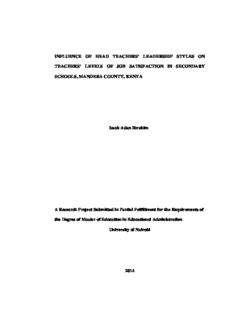
Influence of head teachers' leadership styles on teachers' levels of job satisfaction in secondary PDF
Preview Influence of head teachers' leadership styles on teachers' levels of job satisfaction in secondary
INFLUENCE OF HEAD TEACHERS’ LEADERSHIP STYLES ON TEACHERS’ LEVELS OF JOB SATISFACTION IN SECONDARY SCHOOLS, MANDERA COUNTY, KENYA Issak Adan Ibrahim A Research Project Submitted in Partial Fulfillment for the Requirements of the Degree of Master of Education in Educational Administration University of Nairobi 2014 DECLARATION This research project is my original work and has not been presented for a degree in any other university. ________________________________________ Issak Adan Ibrahim E55/75001/09 This research project has been submitted for examination with our approval as University Supervisors. ___________________________________________ Dr. Rosemary Imonje Lecturer Department of Educational Administration and Planning University of Nairobi _________________________________________ Dr. Jeremiah Kalai Lecturer Department of Educational Administration and Planning University of Nairobi ii DEDICATION This study is dedicated to my family members; my wife Mrs. Zeituna Adan, and children Hannan Adan, Taiha Adan, Ikram Adan, Abdiaziz Adan and Hawa Adan. I also dedicate it to my father in law Hajj Billow. iii ACKNOWLEDGEMENT I extend my most sincere thanks to my supervisors Dr. Jeremiah Kalai and Dr. Rosemary Imonje for their guidance, professional advice and constructive criticism which kept me going to the end. I also want to thank my family members; my wife Mrs. Zeituna Adan, and children Hannan Adan, Taiha Adan, Ikram Adan, Abdiaziz Adan and Hawa Adan for the support and encouragement they gave me during my studies. Special thanks go to my father in law Hajj Billow for his support. I also want to sincerely thank all the respondents in this study; the school headteachers and teachers in Mandera County since without their participation, this study would not have this final stage. To all mentioned and unmentioned but supported this study, I say a big thank you. iv TABLE OF CONTENT Content Page Title Page ................................................................................................................. i Declaration .............................................................................................................. ii Dedication .............................................................................................................. iii Acknowledgement ................................................................................................. iv Table of content ...................................................................................................... v List of figures ......................................................................................................... ix List of tables ............................................................................................................ x Abbreviations and acronyms ................................................................................ xii Abstract ................................................................................................................ xiii CHAPTER ONE INTRODUCTION 1.1 Background to the study ................................................................................... 1 1.2 Statement of the problem .................................................................................. 9 1.3 Purpose of the study ........................................................................................ 10 1.4 Objectives of the study ................................................................................... 11 1.5 Research questions .......................................................................................... 11 1.6 Significance of the study ................................................................................. 12 1.7 Limitations of the study .................................................................................. 12 1.8 Delimitations of the study ............................................................................... 12 v 1.9 Assumptions of the study ................................................................................ 13 1.10 Definitions of significant terms .................................................................... 13 1.11 Organization of the study .............................................................................. 14 CHAPTER TWO LITERATURE REVIEW 2.1 Introduction ..................................................................................................... 16 2.2 Leadership styles and employee job satisfaction ............................................ 16 2.2.1 Autocratic leadership style and employees’ job satisfaction ................ 17 2.2.2 Democratic leadership style and employees’ job satisfaction .............. 21 2.2.3 Laissez-faire leadership style and employees’ job satisfaction ............ 25 2.3 Summary of literature review ......................................................................... 27 2.4 Theoretical framework .................................................................................... 28 2.5 Conceptual framework .................................................................................... 30 CHAPTER THREE RESEARCH METHODOLOGY 3.1 Introduction ..................................................................................................... 31 3.2 Research design .............................................................................................. 31 3.3 Target population ............................................................................................ 31 3.4 Sample size and sampling procedure .............................................................. 32 3.5 Research instruments ...................................................................................... 33 3.6 Validity of the instruments ............................................................................. 33 3.7 Reliability of the instruments .......................................................................... 34 vi 3.8 Data collection procedures .............................................................................. 34 3.9 Data analysis techniques ................................................................................. 35 CHAPTER FOUR DATA ANALYSIS, INTERPRETATION AND DISCUSSION 4.1 Introduction ..................................................................................................... 36 4.2 Questionnaire return rate ................................................................................ 36 4.3 Demographic data of the teachers ................................................................... 40 4.4 Head teachers’ perception of their leadership styles ...................................... 43 4.5 Teachers’ perceptions of their head teachers’ leadership styles ..................... 47 4.6 Influence of autocratic leadership style on teachers’ job satisfaction ............ 55 4.7 Influence of democratic leadership style on teachers’ job satisfaction .......... 58 4.8 Influence of Laissez-faire leadership style on teachers’ job satisfaction ........ 60 CHAPTER FIVE SUMMARY, CONCLUSION AND RECOMMENDATIONS 5.1 Introduction ..................................................................................................... 64 5.2 Summary of the study ..................................................................................... 64 5.3 Conclusions ..................................................................................................... 66 5.4 Recommendations ........................................................................................... 69 5.5 Suggestions for further research ..................................................................... 69 REFERENCES .................................................................................................... 71 APPENDICES Appendix I:letter of Introduction .......................................................................... 77 vii Appendix II:Questionnaire for head teachers ....................................................... 78 Appendix III:Questionnaire for teachers .............................................................. 83 Appendix IV:Authorization letter ......................................................................... 91 Appendix V:Research permit ................................................................................ 92 viii LIST OF FIGURES Figure Page Figure 2. 1 Conceptual framework ................................................................................ 30 ix LIST OF TABLES Table Page Table 4. 1 Gender distribution of the head teachers ............................................. 37 Table 4. 2 Age distribution of the head teachers .................................................. 38 Table 4. 3 Professional qualification of the head teachers .................................... 38 Table 4. 4: Head teachers’ teaching experience in years ...................................... 39 Table 4.5: Head teachers’ distribution by school category ................................... 40 Table 4. 6: Distribution of the teachers according to age ..................................... 41 Table 4. 7: Teachers’ academic/professional qualifications ................................. 41 Table 4. 8: Duration of teachers in present schools .............................................. 42 Table 4.9: Teachers’ responsibilities .................................................................... 43 Table 4. 10 Head teachers’ perceptions of themselves as autocratic leaders ........ 44 Table 4. 11 Head teachers’ perception of themselves as democratic leaders ....... 45 Table 4. 12 Head teachers’ perception of themselves as laissez fair leaders ........ 46 Table 4. 13 Teachers’ perceptions of the leadership style of their head teachers . 47 Table 4. 14 Teachers’ perceptions of the leadership style of their head teachers . 48 Table 4. 15 Teachers’ perceptions of their head teachers’ leadership style .......... 50 Table 4. 16 Teachers’ level of satisfaction with working conditions in their schools................................................................................................................... 51 Table 4. 17 Teachers’ satisfaction with pay and promotion ................................. 52 Table 4. 18 Teachers’ level of satisfaction with work relations ........................... 53 Table 4. 19 Teachers’ level of satisfaction with use of skills and abilities ........... 53 x
Description: